After Rejection, Advocates Continue Push to Remove Confederate Talbot Boys Monument
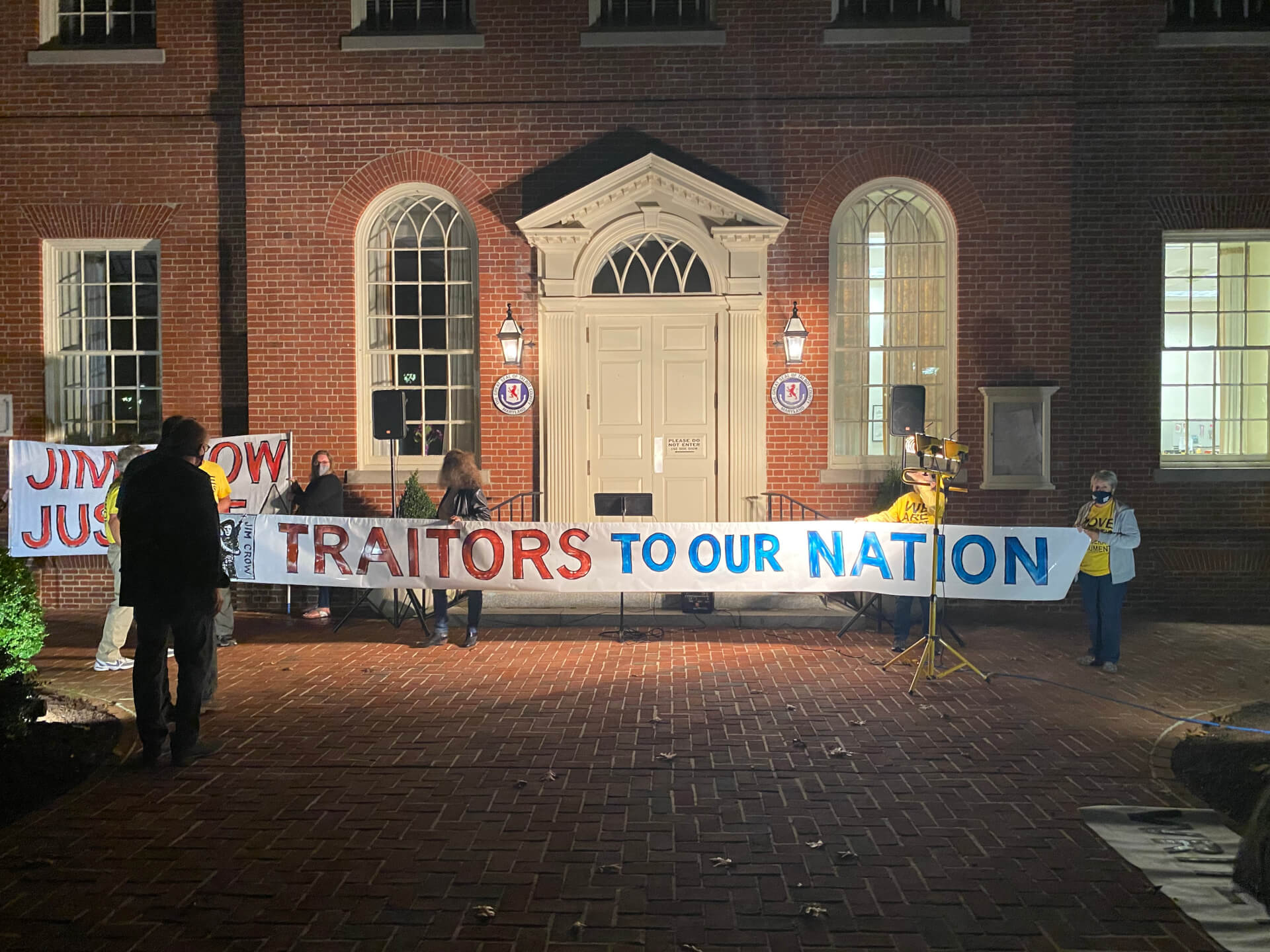
For Ryan Ewing, the debate over removing a Confederate statue from the Talbot County courthouse lawn is personal: One of his family members is among those memorialized on the monument.
Ewing, a public defender who grew up in Talbot County, spoke to dozens of residents at a rally to bring down the Talbot Boys statue last week. He told protestors at the Nov. 10 rally that the monument’s continued presence at the courthouse flies in the face of the United States justice system’s promise of fair trials.
“We ensure the appearance of fairness in every way that we can,” Ewing said. “It’s what we do in our justice system. And my question to everyone is: Does the presence of this statue give any of my clients the appearance that they will get a fair trial?”
The Talbot Boys monument includes a statue of a soldier holding a Confederate battle flag. That flag has long been used to represent southern heritage, according to the Anti-Defamation League, but is sometimes also used as a symbol of racism and white supremacy.
It stands adjacent to a statue of Frederick Douglass, the prominent abolitionist who was once jailed in Talbot County while attempting to escape slavery.
Ewing said he won’t miss his family’s name on the monument if it’s moved from where it stands outside of the county courthouse. He prefers to memorialize his family members who fought in other wars, like his great uncle who was shot down over occupied France during World War II.
Talbot County Council members voted to keep the Confederate statue on the county courthouse’s grounds earlier this year – but for local advocates and residents, the fight to bring down the monument is far from over.
As county council members were meeting last Tuesday, dozens of residents crowded the lawn of the courthouse to demand the removal of the Talbot Boys, a century-old monument that memorializes county residents who fought for the Confederacy during the American Civil War.
The Confederate monument has been a flash point in the county for years, with residents clashing over the memorial’s meaning and message. Those who want the statue to stay say the memorial isn’t meant to perpetuate a racist message, but opponents argue the statue’s presence is an ugly reminder of the county’s history of slavery and segregation.
According to data from the U.S. Census, roughly 12.8% of the county’s population is Black. The county’s population has been steadily increasing over the past decade, and it’s electoral makeup is changing as well: former vice president Joe Biden took the lead in Talbot County last week, potentially making him the first Democratic presidential nominee to win the county in more than 50 years.
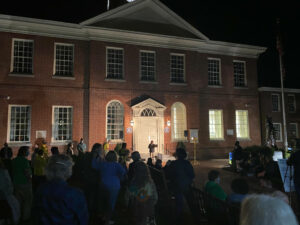
Residents protested the continued presence of the Talbot Boys monument after a rally earlier this month. Photo by Bennett Leckrone.
At the protest, county residents homed in on the Confederacy’s connection to slavery in demanding the monument’s removal, arguing that the Talbot Boys statue’s presence at the courthouse is inappropriate.
Keith Watts, a retired labor attorney, told protesters that the monument stands on the grounds of a former slave market, and said the Confederate symbol shouldn’t be allowed on grounds where families were split up forever.
He also addressed criticism of the movement to remove the statue, wherein advocates are accused of attempting to erase or censor history.
“I’m not advocating erasing history,” Watts said. “I’m advocating relocation.”
JoAnn Asparagus, a longtime magistrate for the Caroline County Circuit Court, noted that some who oppose the statue’s removal charge that slavery wasn’t the main reason for the Confederacy’s split from the Union.
“I don’t care whether it was the main reason, second or third,” Asparagus said. “It was a reason.”
Others pointed to Confederate Vice President Alexander H. Stephens’ “Cornerstone Speech” as evidence linking the Confederacy to systemic racism and slavery. In that speech, Stephens said the “cornerstone” and foundation of the Confederacy was slavery and racial inequality.
“There are those who claim that removing that monument changes history,” Michael Pullen, a longtime local attorney, said after reading a portion of Stephens’ speech to the protesters. “I wish we could erase the 400 years of slavery, and the kidnapping, rape, torture, death, murder, the horror and terrorism that followed. I wish we could erase all of that by taking that statue down.”
Continued controversy
As Confederate monuments were toppled across the country amid a wave of protests against systemic racism and police brutality earlier this year, Talbot County Council members narrowly decided to keep the monument on the courthouse lawn.
Council members rejected a proposal to remove the Talbot Boys in a 3-2 vote at an August meeting. In voting to keep the monument up, Republican council members said the Confederate monument’s fate should ultimately rest in the hands of community members.
“This should be in the hands of the community, and not our hands,” Council Vice President Charles F. Callahan III (R) said in rejecting the resolution.
The contested vote came amid pressure from state and federal officials to remove the monument. U.S. Sen. Chris Van Hollen (D) and Maryland Comptroller Peter V.R. Franchot (D) had both publicly called on county council members to remove the monument.
Republican Council President Corey W. Pack, who led the charge in attempting to remove the monument, was disappointed in the resolution’s failure. At the time, he warned that having a confederate monument outside of the county courthouse sends the wrong message to community members.
“I do not support the Talbot Boys statue remaining on the courthouse lawn,” Pack said in August. “It is not appropriate to keep that symbol on the courthouse lawn.”
Pack and Peter Lesher (D) voted to remove the monument, but the other Republicans on the council, Laura E. Price, Frank Divilio and Callahan, voted to keep the statue up.
The debate over the Talbot Boys memorial isn’t a new one for county residents: In 2015, the county council voted to keep the statue after the local NAACP campaigned to remove it. At the time, Pack said the Confederate monument should stay on the courthouse grounds, arguing that removing it would be “disrespectful to the family members” of the soldiers memorialized.
Pack’s reversal and recent drive to remove the Talbot Boys came after the killing of George Floyd by police in Minneapolis earlier this year. Floyd’s death sparked nationwide protests over police brutality and led to a renewed conversation about whether Confederate monuments should stand on public property.
In one of his final acts as Wicomico County Executive before his death, Bob Culver (R) removed a Confederate marker in Salisbury in June. The movement among local governments to remove Confederate monuments had continued in recent months: Just two weeks ago, officials in Fairfax County, Va., ordered the removal of several Confederate markers and memorials from their county courthouse.
Asparagus, the magistrate, told the crowd outside of the Talbot County Courthouse that Mississippians had voted to remove a Confederate symbol from their state flag during the Nov. 3 election. She encouraged county residents to continue to push council members for the statue’s removal.
“They don’t go down easy,” Asparagus said.
Continued conversations
Richard Potter, the president of the Talbot County NAACP, said he tried to convene a meeting between advocates and county council members in late October. County council members rejected his request, Potter said, because they didn’t want to discuss the Talbot Boys monument publicly.
Pack said at an Oct. 27 meeting that the Talbot County Council hadn’t met with the NAACP in roughly five years. While Lesher and Pack weren’t opposed to meeting with Potter’s group, Price, Divilio and Callahan said they weren’t ready to convene a workgroup.
“We know that this is not a finished, done deal,” Price said. “I don’t want anybody to think that we’re just digging in and we’re not continuing to talk with members of the community and leaders in the community.
Lesher told Maryland Matters that other council members thought the next step in dealing with the Talbot Boys memorial was to encourage constituents to meet with them one-on-one instead of hosting public debates or workshops.
“I personally don’t see what’s wrong with convening a workshop,” Lesher said. “But I’m willing to work with whatever will give us a path forward. If that’s what will move us forward, I’ll work with that.”
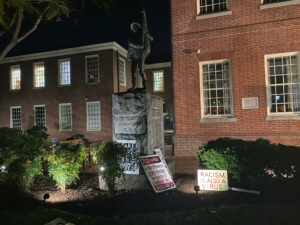
Residents left signs protesting the continued presence of the Talbot Boys monument after a rally earlier this month. Photo by Bennett Leckrone.
Callahan said at the Oct. 27 meeting that he wants the next phase of debate over the Talbot Boys monument to start with one-on-one conversation. He said he wants to “iron some things out” in private to have a more informed conversation during future public meetings.
Price said some county residents might not be comfortable sharing their views on the Confederate monument on public record, noting that a meeting with a majority of the county council must be public record under the Maryland Open Meetings Act.
“Speaking individually, one-on-one, I believe is going to be a lot more productive at this time,” she said.
Potter accused council members of stalling the conversation about the Confederate monument instead of addressing it head on, and vowed to continue pushing for the removal of the monument.
“Nothing has been done,” Potter said. “I think these are all stall tactics, to not … address the issue. And we’re going to keep pressing on.”
Potter said he thinks the monument will hamper Talbot County’s efforts to modernize and grow moving forward, and said he thinks the time has come for officials to take another look at removing the statue.
“I think it has its place in our history,” Potter said. “But the place of it being on the courthouse lawn is no longer. It was there to send the message of hate. It was there to scare Black people. And that’s not our community anymore.”
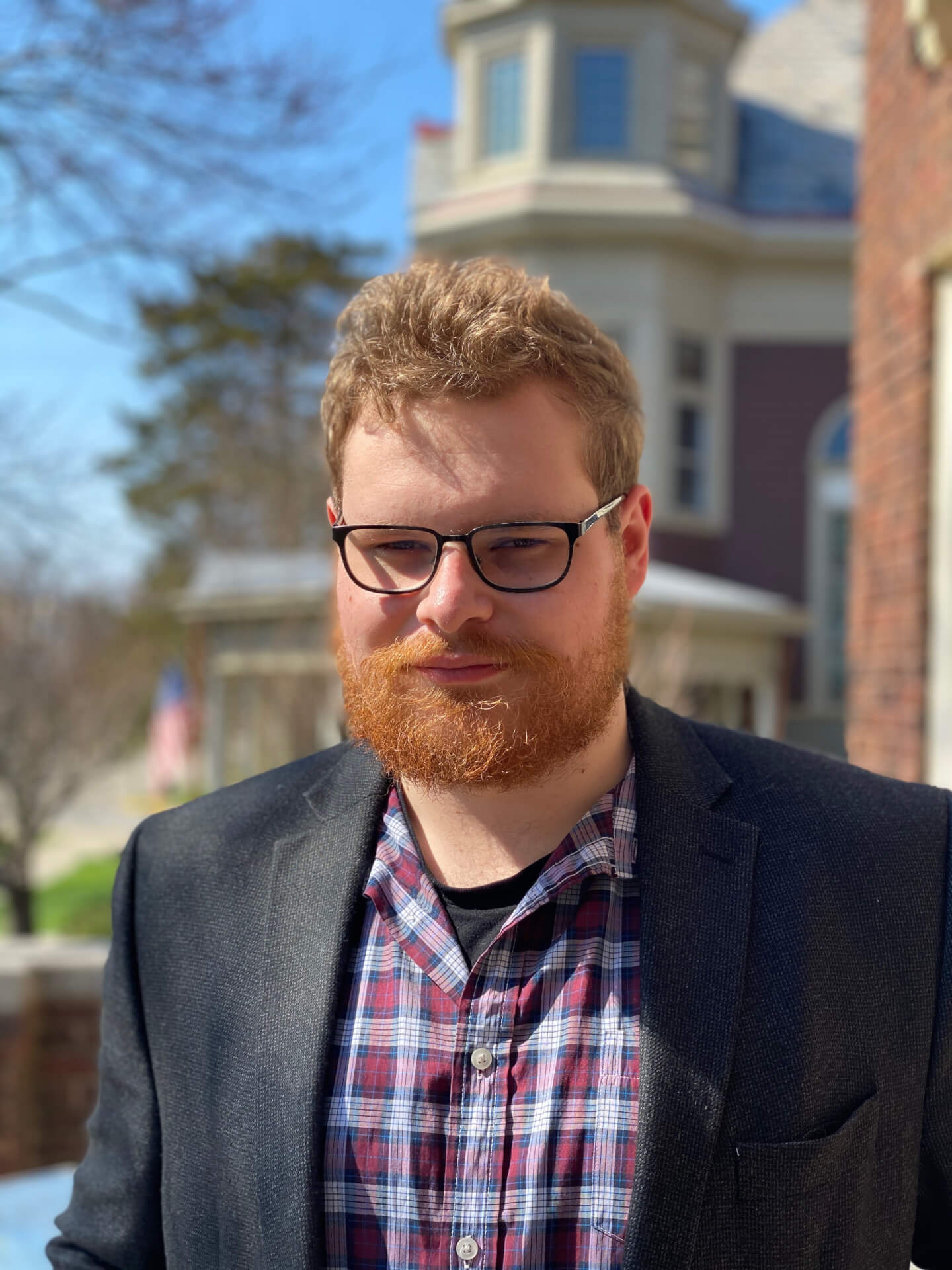

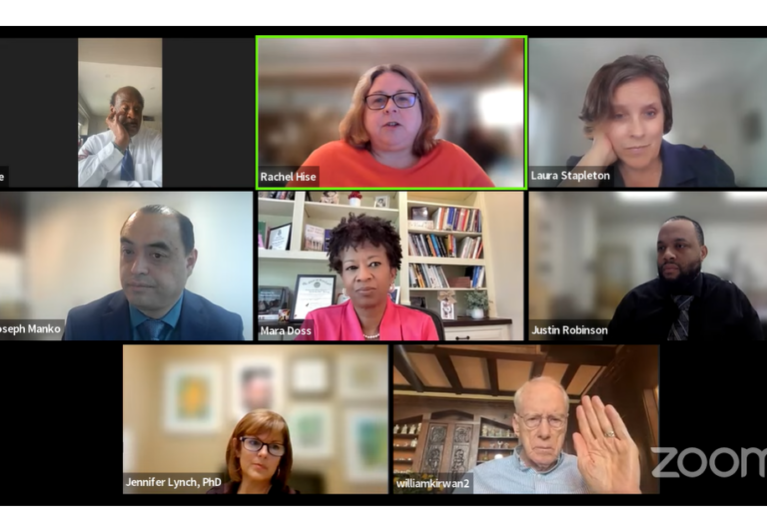
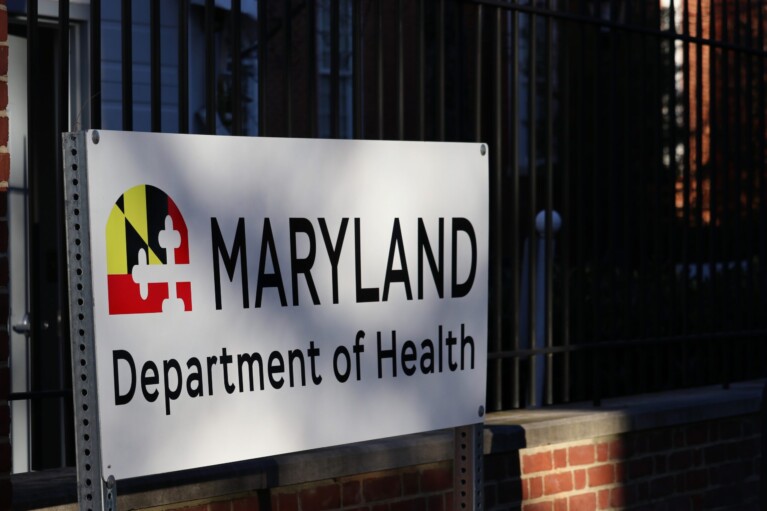
 Creative Commons Attribution
Creative Commons Attribution